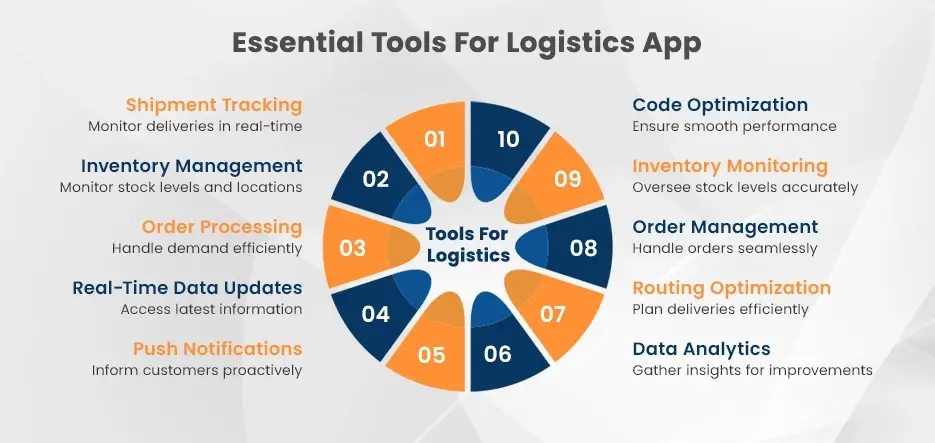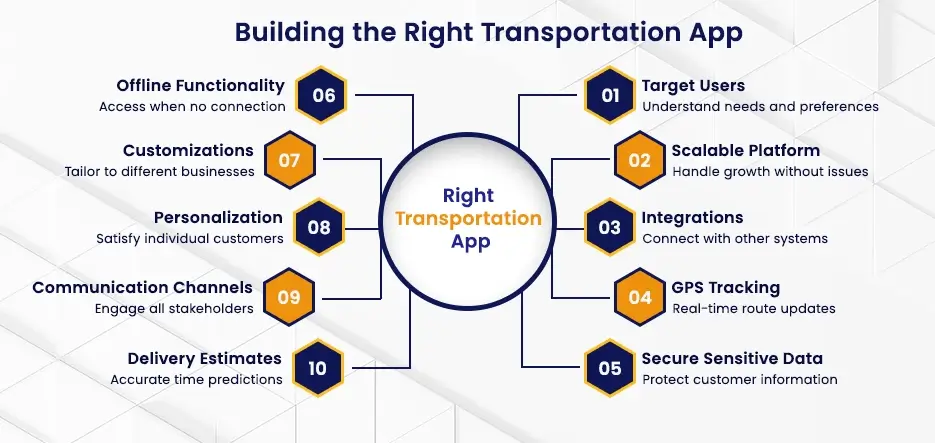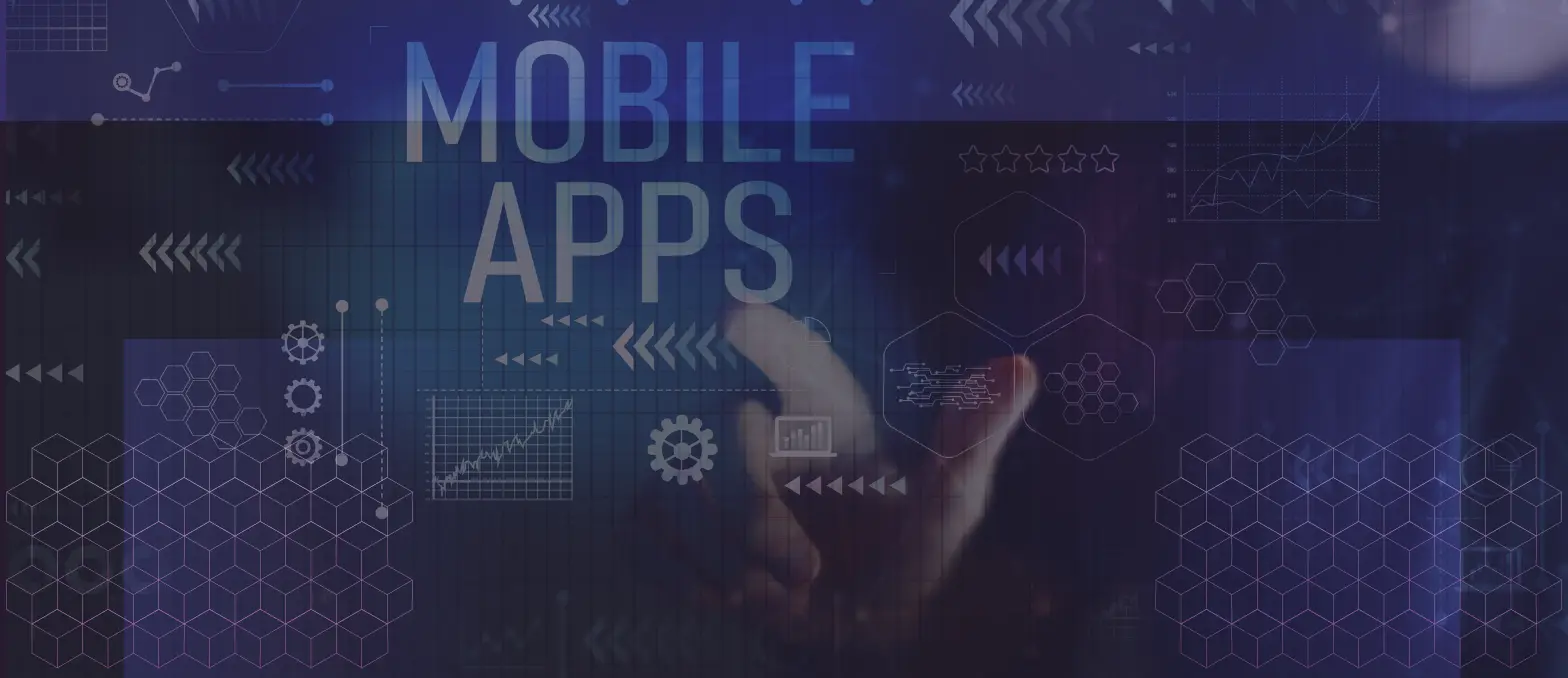Table of Contents
Our complete guide of Logistics App Development is available to assist you at each step of the way. From knowing the elements that contribute to the growth of logistics industry‘s requirements to creating user-friendly interfaces and then the implementation of crucial features, we’ll become your reliable partner. We’ve packed this guide full of useful tips and information to help make your app development journey easy and profitable.
Continue reading to discover the thrilling realm of logistics app development all together!
Are you in the market to develop an application for your logistics that will increase the efficiency of your business’s logistics?
Do you wish to provide your clients with a smooth and easy transportation experience?
Are you wondering how to track your drivers and fleet without difficulty?
If you’re asking yourself these things you ask yourself each throughout the day as you go about your daily routine? You’re at the right spot as this guide will provide all the answers.
Logistics plays an essential role in the success of any organization. Logistics app development with digital twin technology could be to improve efficiency, streamline operations, the efficiency of managing supply chains or increase overall efficiency.
This blog you’ll discover all you need to know about custom logistics app development and the ways it could transform your logistics company. Take a look and end the long-winded paper-based tracking and paperwork and satisfy customer demands with an app that is mobile-friendly. Mobile application development services can assist you in taking your company to new levels. Take advantage of the new logistics technology with an app that is user-friendly. Let’s get started.
Simplify Your Logistics with Our Innovative App Solutions
How To Create A Logistics App?
The top custom mobile app development company in the business has provided below the most-effective steps of logistics app development. Take a look.
Define Your Objectives
The first step to take in the logistics mobile app development is to clearly define your goals. Decide on the type of mobile logistics app you’d like to create. Consider your specific sector, your target market and your business requirements. You might want to consider incorporating features related to:
- Packaging
- Procurement
- Warehousing
- Freight forwarding
- Managing inventory
- Shipping across the border
- Last-mile delivery
- Returns and replacements
With the right options, it is possible to design an app specifically tailored to your requirements and goals. By focusing on preparation and implementation, you will be able to develop an app that will simplify your processes, increase efficiency, and increase profits.
Building the Foundation – Technology and Infrastructure
The basis of a well-functioning logistics application is its infrastructure and technology. As a house requires solid foundations to withstand all elements. A mobile app requires a solid technology stack that can handle the demands of a complicated and constantly changing industry.
When you are choosing a stack of technology to run your logistics app it is possible to explore various frameworks, technologies, or programming languages. There’s a broad range of options to choose from which is why it’s essential to research thoroughly and choose the right one for your application.
If you think carefully about the needs for infrastructure and technology of your logistics application, you’ll be able to build a foundation that will help ensure your app’s success in the decades to the future.
User Experience Design: Creating Intuitive Interfaces
The top app development companies in USA state that there is a greater need than ever to design easy-to-use and user-friendly logistics applications. With the variety of options available users are quick to quit an app that’s difficult to navigate or use.
This is where user experience design (UXD) is a key element. There are a variety of elements that are essential to a good UX design to build a logistics app. This includes as given below.
- Seamless user flow: User flow is the route that users use to navigate through an application. A well-designed user flow is simple to understand and can make it simple for users to finish their work.
- Navigation that is intuitive: Navigation is the system used by users to navigate around an app. A well-designed navigation system is simple and easy to use and helps users locate the information they require quickly and effortlessly.
- Unique User Interfaces: This includes use of clean fonts, colors and icons to assist users comprehend the application’s capabilities.
- Utilization of visual elements: Such as graphics, icons and color schemes are a great way to increase accessibility and make apps more appealing to the eye.
- Feedback and testing by users: User testing is the process of gathering feedback from users regarding an application. The feedback is utilized to find and address usability issues.
If you stick to these rules and follow them with discipline, you will be able to develop logistics applications that are easy to use, effective, efficient, and entertaining. This will help you draw and keep users in your app and provide you with an edge in the marketplace.
Developing Core Logistics App Features and Functionality
According to a logistics app development company, the fundamental features and capabilities of a logistics application are the basis on which it goes for development. Without these fundamental attributes, your application is insufficient and not able to meet the requirements of your customers.

The most crucial key features that can help one get rid of all modern logistics challenges are:
Tracking of Shipments: Allows users to keep track of the progress of their deliveries in real-time. This is crucial for giving assurance for customers, and also ensuring they get their order in time.
Management of Inventory: This feature allows users to monitor the amount and the location of their inventory. This is vital to ensure there is enough stock to meet the demand. Also to assure that your goods are efficiently kept for the requirement.
Processing Orders: Users can process orders quickly and effortlessly. This is crucial to ensure that you’re able to keep pace with the demand and ensure that your customers enjoy a pleasant experience.
Real-time Updates to Data: This feature allows users to get the most current information about their inventory, shipments, and orders. This is crucial to make informed choices and making sure that your operations run smoothly.
In addition to these essential capabilities There are a variety of other functions that can be integrated into logistics management software. They include:
Optimization of the App: App optimization is crucial to ensure that your app functions well and smoothly. This can include things like optimizing your code, utilizing the proper tools, and testing your application thoroughly.
These essential features and functions can help you meet the demands of the best logistics app customers. Then, you can develop a logistics application that is both profitable and effective.
Data Management and Analytics
The new fuel is data. It’s the vital ingredient of a profitable business and logistics apps aren’t an exception. Through the collection and analysis of information, apps for logistics can get valuable insight into customer behavior and supply chain optimization and process enhancements. The data can make better choices, increase efficiency, and cut costs.
There are a variety of different methods in logistics app development services of collecting information that deal with logistics. A common technique is to make use of sensors to monitor the movement of goods and other materials. The data also helps to track the exact location of deliveries as well as identify bottlenecks within your supply chain and improve the delivery routes.
Another method of collecting information for apps that deal with logistics is to utilize questionnaires and surveys to collect feedback from customers. The information can improve users’ experience and pinpoint areas that need improvement and make better choices regarding future features.
After the data can help to discover valuable information. This can be done by using a range of methods, including machine-learning and statistical. Through the analysis of the data, apps for logistics can get a better knowledge of their customers as well as their supply chains and their process. This information can help in making better choices, increase efficiency, and lower expenses.
Note: If you’re creating an on demand logistics app ensure that you make the management of data and analytics a top priority. This could be the key in your company’s growth.
Testing and Quality Assurance
The best eCommerce development companies claim that testing and quality control (QA) is crucial to ensure the success of any logistics software.
In addition to these kinds of tests, it is essential to gather comments from the users during the process of developing. The feedback can pinpoint areas of improvement and ensure that the application fulfills the needs of users.
By following these best practices in custom mobile app development services, you can be sure that your logistics application is of top quality. It is able to meet the requirements of the users.
Unlock Efficiency & Maximize Productivity with Our Logistics App Development Services!
Deployment and Maintenance
Maintenance and deployment are crucial for the long-term success of any app for logistics. If you follow these guidelines and procedures, you can be sure that your application is accessible and current and is able to meet the demands of its users.
Deployment
Once your app is designed as well as tested the time to release it on the platforms you want to use it on. The procedure will differ based on the platform but it usually involves uploading the app to the store or the website.
Maintenance
It is crucial to keep it updated and to maintain it. This means monitoring the performance of your app as well as gathering feedback from users and fixing any issues quickly. Also, you should frequently make sure that your app is in update with new features and enhancements. Here are some helpful tips to ensure a successful deployment and maintenance:
Choose the Best Platform: When choosing platforms to launch your app on be sure to consider the audience you want to reach along with the capabilities you would like to provide.
Make Sure you Test Extensively: Before you deploy your application, ensure that you test it thoroughly on every platform. This will allow you to identify any bugs or issues prior to them being reported to users.
Performance Monitoring: When your web application is installed, you should be sure to monitor its performance carefully. This will allow you to identify the performance problems that require to be taken care of.
Get Feedback from Users: Ask users for their feedback about your application. The feedback you receive can enhance the app to meet the demands of the users.
Fix Issues Immediately: If you receive any issues or complaints regarding your app, resolve them immediately. This will ensure that your app keeps customers satisfied and avoids negative reviews.
Update Frequently: Regularly update your app with new features as well as enhancements. This keeps users interested and returning to learn more.
If you do this repeatedly, you can be sure that your logistics application will be successful over the long run.
So, how do you make an app similar to Uber? These on demand app development company steps are a good place to begin. However, if you’re looking to find something better, we’ll even take a look at the features listed below.
The Most Important Characteristics of the App for Logistics
Supply chain management software market globally is expected to expand by 4.52 percent (2024-2028) which will result in an estimated market size that is US$24.19bn by 2028. A logistics application is an effective device that helps companies to better manage their shipments. However it is important to note that not all logistics applications are designed the same way. Some are designed specifically for the needs of the administrator in mind, whereas others are created with the needs of the driver or customer in the back of their minds.
According to an ecommerce app development company, the best logistics applications are created with the requirements for all the three stakeholders in the back of their minds. That means the application should include features that allow administrators to oversee their shipping, the customer to keep track of their deliveries, while allowing the truck driver to finish their delivery.
Here are a few things to be included in every section of a logistic app:
The Admin Dashboard: Your Command Center
Administrator dashboards are your single-stop place to manage your logistics process. From here, you’ll be able to look over everything from new orders to locations for drivers. By using the admin dashboard, you’ll be in control of your operations and ensure everything is functioning smoothly.
Here are a handful of the things you could do using the administrator dashboard:
- Review incoming order and then assign the orders to driver
- Keep track of the locations of your vehicles and drivers
- Monitor the levels of fuel and schedule maintenance
- Connect with customers and drivers.
- Reports on your operation can be generated.
An admin dashboard is an effective tool that can assist you increase the efficiency and profits of your logistics operations. If you’re seeking a way for your business to go into the future, then the administration dashboard could be the best starting point.
Fleet Management: The Key to a Successful Logistics Operation
The process of managing fleets is of overseeing and directing vehicles in a fleet. It involves tasks like monitoring the location of vehicles, tracking the level of fuel or scheduling repairs. The management of fleets is crucial for any business that has vehicles in a fleet, because it helps enhance efficiency, decrease costs, and enhance security.
Manage Your Drivers Effectively
Here are some suggestions for effectively managing your drivers:
Find out more about the drivers you have: Make the effort to learn about each driver on a personal basis. Find out about the strengths and weaknesses of each as well as their goals and their hobbies. This will assist you in developing connections with them and help make your workplace a more positive one.
Make clear the expectations you want: Make sure your drivers understand what’s expected of them. This includes matters like the hours they work as well as their duties, as well the policies of the company.
Regularly provide updates: Let your drivers know how they’re doing. This will help them keep their motivation up and help them improve their performance.
Be sure to recognize and praise great performances: When your drivers are doing a great job making a difference, you should acknowledge and give them a reward. It will show them you appreciate their efforts and will encourage them to keep performing at a high-level.
Develop and train your drivers possibilities: Help your drivers to develop and improve their abilities. This makes them more beneficial to you as an organization and will help them advance in their career.
Create a happy work atmosphere: Make sure your drivers feel valued and respected. This will create an atmosphere of positivity and satisfaction in which they feel motivated to perform their best.
With these suggestions, you will be able to organize your drivers well and ensure they’re valuable for your business.
Chat Functionality: A Must-Have for Any Logistics App
Chat is a vital element of every logistics app. It lets administrators remain in constant contact with their drivers and clients that can assist to solve issues faster and increase the customer experience.
Managing Income and Expenditure
The worldwide market for software is expected to expand by 5.27 percent (2024-2028) leading to the market size in the range of US$858.10bn for 2028. Logistics businesses incur a lot of costs, which is why it’s crucial to manage these expenses with care. Administrators are accountable for appraising and disapproving expenses for drivers such as toll taxes and fuel prices, as well as many more. They also have complete control over expenditure and income management.
The logistics apps can be integrated in conjunction with AI technology to enhance and simplify the analysis of financial statements. This helps administrators comprehend the profit/loss ratio, by comparing various parameters.
Push Notifications: A Way to Attract and Delight Customers
Push notifications are a fantastic method to keep in touch with your clients and keep them informed about their deliveries and orders. They can be used to also send invoices, driver information, as well as delivery information.
Customer Panel
Sign Up
Sign-up for your app must be simple, straightforward and fast. It should integrate with social media platforms to make it simpler for users to sign-up. This will allow you to increase the number of customers you can sign up and also gather their email address and information about their social media accounts.
To make a simple and straightforward sign-up process you can make use of an online Single Sign-On (SSO) provider. Make the sign-up form short and easy, make use of an easy and simple language and give a sign-up incentive.
Notify Users
The notification feature lets you keep your users informed about the status of their delivery. It is also possible to notify users that an item is due to arrive.
To make the most of this feature ensure that the notifications are concise, clear, relevant, and delivered at the appropriate time. Also, you should examine the notifications prior to giving them to users.
Payment Gateway
When creating an on-demand logistics application, it’s essential to incorporate the payment gateway that allows users access to payment for delivery without carrying cash. The payment gateway must support various payment options including debit cards, credit card, mobile wallets and PayPal.
Integrating a payment processor into your application will make it easier for your customers to utilize your app and aid in reducing the chance of fraud.
Monitoring/Tracking
The feature of tracking orders gives customers a sense and security. It also aids in building trust between businesses and customers. Through tracking their orders customers are able to see the estimated delivery time and the location of the driver. This will give customers assurance that their order is on the journey and will arrive on time.
Feedback & Suggestions
Feedback from customers is crucial for the industry of transportation. It helps you find areas for improvement, boost satisfaction of customers and boost sales.
To gather feedback from your customers, you could post an online feedback form on your app or website or distribute surveys. Be specific about the information you’re looking for, like suggestions for improvements, new features, areas of improvement, or a general feeling of satisfaction. React quickly to feedback and respond to feedback you are able to take action on.
Driver Panel
Registration
This feature for drivers is essential for logistic companies since it allows them to manage who can access their platform.
Profile of the Driver
The feature for drivers lets both the administrator and the driver edit or modify information about the driver. The administrator can manually add information about the driver while the driver is able edit or add their own details using the application. All information about drivers is stored within the app’s backend.
Product Delivery Screen
The screen for delivery of the product in the application shows drivers an overview of scheduled and scheduled deliveries along with relevant information such as the product being assigned for delivery, delivery address, name of the customer and the phone number. This allows drivers to plan their delivery and deliver the order in time.
Electronic Confirmation of Delivery
Traditionally delivery drivers were to be accountable for any theft that occurred during delivery. It was a stressful and lengthy procedure for drivers as they were required to file reports and assist with investigations and at times, pay for stolen goods through their own pockets.
Push Notifications
Push notifications are an excellent method for drivers to remain active and informed. They are used to inform drivers of recent orders and changes to scheduled orders as well as messages from admins or customers. Push notifications are also utilized to protect drivers by averting them of dangers that could be present.
Things to take into Consideration when Developing a Transportation Application
When developing a transportation application there are a variety of things to be considered to ensure the app’s success:

Target Audience
Learn about your intended audience’s requirements, preferences, needs, and issues. Customize your app’s features and experience for users to satisfy the specific needs of your audience, whether it’s B2B logistics, or last-mile delivery.
Scalability
Plan for future growth and develop your logistics software to manage an increase in user traffic and data volume. Scalability is vital to support the growing demands without compromising performance.
Integration Capabilities
You might consider integrating your logistics application with other systems like ERPs and CRMs as well as transportation management systems (TMS). This will streamline the flow of data and increase overall efficiency.
GPS and Geolocation
Use GPS and geolocation to track your deliveries, optimize routes and give accurate delivery estimates. Updates on location in real-time enhance visibility and increase customer satisfaction.
Security and Data Privacy
Secure sensitive data like customer data, financial information and supply chain information. Use strong security measures to avoid data breaches and unauthorised access.
Offline Functionality
Allow offline function to ensure uninterrupted use of the app particularly in areas with weak internet connectivity. This feature lets drivers remain connected to important information while updating information.
Customization and Personalization
Offer customization options to satisfy the individual needs of various businesses. Set up and customize features to improve customer engagement and satisfaction.
Seamless Communication
Create effective channels for communication for all stakeholders, including drivers, customers and support staff. Introduce chatbots, messaging in the app or features for customer support to make it easier for everyone to communicate.
Logistics Mobile App Development Cost
The average cost per employee within the Supply Chain Management Software market is predicted to reach US$5.78 in 2024. As per eCommerce app development services expert, the cost of creating an app for logistics is contingent on several variables. This includes:
- The application’s features are complex: The more complex the app’s features are, the more costly it will cost to create.
- The time to develop: The longer it takes to create the application the more expensive it will cost.
- Technology stack: This tech stack that is used to create the application will also impact the price.
- The Design Requirements: The more complex the design needs, the more costly it will be to design the application.
- The location of the development team: The location of the development team’s location will influence the price.
It is advised to speak with an experienced agency for app development or experts to obtain accurate costs based on your particular requirements.
Here are a few additional variables which could impact the development cost of an app for logistics:
Users: The more users the application is expected to attract the more costly it will cost to develop.
The security level: The higher the security requirements the higher the cost will cost to create the application.
The requirement for continuous maintenance: If the application requires regular maintenance, it will increase the overall costs of development.
In the end, the cost of transportation management software development could vary dramatically. Also, it is essential to take into consideration all the aspects in the process before making a final decision on whether or not to create an application.
Final Thoughts
The development of logistics apps is a process and not a destination. It’s an ongoing process of improvement and advancement. Also, when you work with a reputable Logistics app creation firm You can begin on this journey and build an app that is customized to meet your needs.
On the way you’ll discover new information and explore new possibilities. Also, you’ll also make connections with other people who share your love of technology and logistics. Most importantly you’ll be able to create something that is able to have a significant impact on the world. A3Logics is a renowned mobile ecommerce solutions provider in the business that is composed of skilled and knowledgeable experts to assist you in gaining an advantage in a highly competitive market. offer exceptional services to customers.
So, what are you sitting on? Start your logistics app development journey today!
Book 30 Minutes Free Consultations with A3Logics Experts to Start Your App Journey Today!
FAQs
What’s the main difference between a logistics app and a transport app?
A logistics application typically covers more functions such as procurement, inventory management and warehousing. Also, a transportation application focuses on the management of items from one location to another.
Do I have the ability to integrate my logistics application with other systems?
Yes, you can connect your logistics software with your existing systems, such as ERPs or CRMs to simplify the flow of data and increase the efficiency of operations.
What are the ways that a logistics application can help my business?
A logistics application can enhance supply chain management, simplify operations, improve transparency and visibility, cut down on errors made through manual processes, optimize routes, and offer more pleasant customer experiences. A3Logics, known for providing custom eCommerce solutions, can help you with it in the best possible way.







